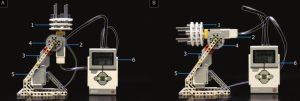DNA origami, the groundbreaking technique of creating complex nanostructures using long, single-stranded DNA scaffold strands and shorter oligonucleotide staple strands, has emerged as a powerful tool for nanoscale engineering. The ability to design nanostructures with arbitrary shapes at approximately 5 nm resolution has opened up a world of possibilities in various fields, including medicine, super-resolution microscopy, and electronics.
However, one challenge has been ensuring the production of pure, uncontaminated DNA origami samples, free from excess staple strands and misfolded structures. Current purification methods, such as agarose gel electrophoresis and spin filter purification, are effective but have limitations, including lengthy preparation times and potential contamination.
Enter the “LEGO Gradient Mixer” – a low-cost, ingenious solution that promises to revolutionize DNA origami purification. Developed using LEGO EV3 Mindstorms materials, this innovative device accelerates diffusion and creates linear glycerol density gradients in just one minute. The LEGO Gradient Mixer employs a simple rotational motion to form smooth gradients, eliminating the need for costly commercial gradient mixers or extended passive diffusion periods.

In purifying DNA origami structures, the LEGO Gradient Mixer creates the glycerol gradient in rate-zonal centrifugation (RZC). RZC separates well-folded DNA origami structures from undesired species, such as misfolded structures and excess staple strands, with high yield and minimal contamination. By combining the advantages of RZC with the speed and cost-effectiveness of the LEGO Gradient Mixer, this method significantly streamlines the purification process.
The potential applications of this groundbreaking technique are vast. Researchers can now produce DNA origami structures on a large scale, making significant strides in nanotechnology and biomedicine. Imagine creating customized nanostructures for targeted drug delivery or developing advanced biosensors for early disease detection. Furthermore, the scalability of this method opens doors for industrial applications, with large quantities of DNA origami structures efficiently purified for use in cutting-edge electronics and nanomaterials.

